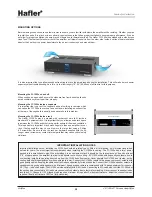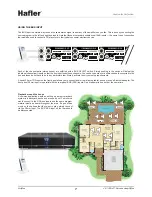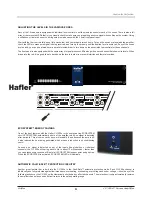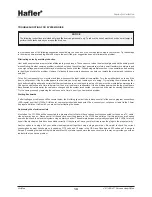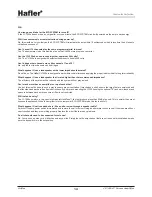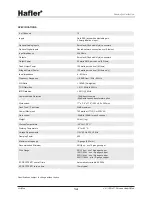
CI-1255e™ Power Amplifier
Hafler
Passion for Perfection
10
TRoubLeShooTING foR SySTem NoISe
NoTICe
The following instructions are intended for qualified service personnel only. To reduce the risk of electric shock do not attempt to
perform these tasks unless you are qualified to do so.
In most cases, one of the following suggestions should help you solve a hum, buzz or sporadic noise in your system. Try these steps
in the order shown, proceeding from one step to the next if the prior suggestion does not eliminate the problem.
eliminating noise by avoiding induction
Hum and buzz problems are most often attributed to ground loops. These can occur when the electrical ground and the audio ground
are conflicting. Another common problem is induced noise on the system from generators, motors, power transformers, dimmers and
even high voltage power cable that may be introducing hash on the line. When using multiple sources, it can sometimes be daunting
to identify and locate the problem. However, following these simple instructions can help you isolate the problem and introduce a
solution.
Turn off all components in your system and then disconnect the input cables at the amplifier. Turn the amplifier back on to see if the
hum is still present. If the hum disappears, the fault may be in the input cables you are using. Try replacing them with cables that
have better shielding and make certain that the input cables are not running on top of any AC power cords or external power supplies.
Change the cables one at a time to determine if one or all cables are responsible. If the hum disappears when the input cables are
disconnected but returns after the cables are changed and the system reconnected, your source device may be causing the problem.
Try the same process by replacing the cables one at a time to see if you can locate a problem.
Starting backwards
If after testing your cables you still encounter noise, the first thing you want to do is disconnect all of the source program connections
(RCA inputs) from the CI-1255e. At this point, your system should be dead quiet. Then, connect your cell phone or tablet to the 3.5mm
bus input and listen. If all is well, you are set to start testing the source.
Addressing the electrical outlets
Most often, the CI-1255e will be connected to a preamp of sorts that will have various sources connected to it such as a TV, cable,
video player and so on. Disconnect all of these and connect the preamp to the CI-1255e and listen. If at this point you are hearing
some noise, check the electrical system using a polarity checker. These simple devices are typically equipped with 3 LEDs to let you
know if the electrical outlets have been wired correctly. If they have not, have your electrician rewire the plugs to the proper polarity.
Another option is to plug all of your audio-visual equipment together using a single power bar. Be careful to check the current
consumption as most circuits are only capable of 115 volts and 15 amps in the USA and Canada and 230 volts and 7.5 amps in
Europe. Exceeding the load will trip the breaker. Most AV systems require more than one circuit, so this may only provide you with an
indicator that you have a problem.
Содержание CI-1255e
Страница 2: ......








